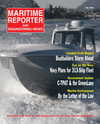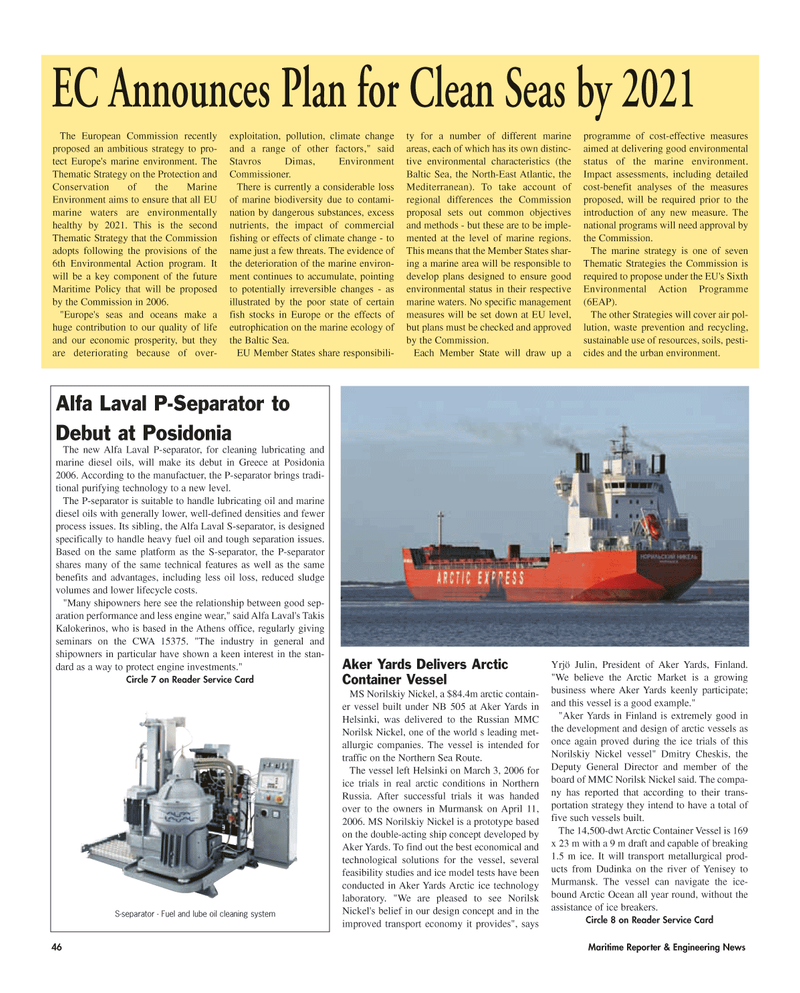
Page 46: of Maritime Reporter Magazine (May 2006)
The Marine Enviroment
Read this page in Pdf, Flash or Html5 edition of May 2006 Maritime Reporter Magazine
46 Maritime Reporter & Engineering News
The European Commission recently proposed an ambitious strategy to pro- tect Europe's marine environment. The
Thematic Strategy on the Protection and
Conservation of the Marine
Environment aims to ensure that all EU marine waters are environmentally healthy by 2021. This is the second
Thematic Strategy that the Commission adopts following the provisions of the 6th Environmental Action program. It will be a key component of the future
Maritime Policy that will be proposed by the Commission in 2006. "Europe's seas and oceans make a huge contribution to our quality of life and our economic prosperity, but they are deteriorating because of over- exploitation, pollution, climate change and a range of other factors," said
Stavros Dimas, Environment
Commissioner.
There is currently a considerable loss of marine biodiversity due to contami- nation by dangerous substances, excess nutrients, the impact of commercial fishing or effects of climate change - to name just a few threats. The evidence of the deterioration of the marine environ- ment continues to accumulate, pointing to potentially irreversible changes - as illustrated by the poor state of certain fish stocks in Europe or the effects of eutrophication on the marine ecology of the Baltic Sea.
EU Member States share responsibili- ty for a number of different marine areas, each of which has its own distinc- tive environmental characteristics (the
Baltic Sea, the North-East Atlantic, the
Mediterranean). To take account of regional differences the Commission proposal sets out common objectives and methods - but these are to be imple- mented at the level of marine regions.
This means that the Member States shar- ing a marine area will be responsible to develop plans designed to ensure good environmental status in their respective marine waters. No specific management measures will be set down at EU level, but plans must be checked and approved by the Commission.
Each Member State will draw up a programme of cost-effective measures aimed at delivering good environmental status of the marine environment.
Impact assessments, including detailed cost-benefit analyses of the measures proposed, will be required prior to the introduction of any new measure. The national programs will need approval by the Commission.
The marine strategy is one of seven
Thematic Strategies the Commission is required to propose under the EU's Sixth
Environmental Action Programme (6EAP).
The other Strategies will cover air pol- lution, waste prevention and recycling, sustainable use of resources, soils, pesti- cides and the urban environment.
EC Announces Plan for Clean Seas by 2021
Alfa Laval P-Separator to
Debut at Posidonia
The new Alfa Laval P-separator, for cleaning lubricating and marine diesel oils, will make its debut in Greece at Posidonia 2006. According to the manufactuer, the P-separator brings tradi- tional purifying technology to a new level.
The P-separator is suitable to handle lubricating oil and marine diesel oils with generally lower, well-defined densities and fewer process issues. Its sibling, the Alfa Laval S-separator, is designed specifically to handle heavy fuel oil and tough separation issues.
Based on the same platform as the S-separator, the P-separator shares many of the same technical features as well as the same benefits and advantages, including less oil loss, reduced sludge volumes and lower lifecycle costs. "Many shipowners here see the relationship between good sep- aration performance and less engine wear," said Alfa Laval's Takis
Kalokerinos, who is based in the Athens office, regularly giving seminars on the CWA 15375. "The industry in general and shipowners in particular have shown a keen interest in the stan- dard as a way to protect engine investments."
Circle 7 on Reader Service Card
S-separator - Fuel and lube oil cleaning system
Aker Yards Delivers Arctic
Container Vessel
MS Norilskiy Nickel, a $84.4m arctic contain- er vessel built under NB 505 at Aker Yards in
Helsinki, was delivered to the Russian MMC
Norilsk Nickel, one of the world s leading met- allurgic companies. The vessel is intended for traffic on the Northern Sea Route.
The vessel left Helsinki on March 3, 2006 for ice trials in real arctic conditions in Northern
Russia. After successful trials it was handed over to the owners in Murmansk on April 11, 2006. MS Norilskiy Nickel is a prototype based on the double-acting ship concept developed by
Aker Yards. To find out the best economical and technological solutions for the vessel, several feasibility studies and ice model tests have been conducted in Aker Yards Arctic ice technology laboratory. "We are pleased to see Norilsk
Nickel's belief in our design concept and in the improved transport economy it provides", says
Yrjö Julin, President of Aker Yards, Finland. "We believe the Arctic Market is a growing business where Aker Yards keenly participate; and this vessel is a good example." "Aker Yards in Finland is extremely good in the development and design of arctic vessels as once again proved during the ice trials of this
Norilskiy Nickel vessel" Dmitry Cheskis, the
Deputy General Director and member of the board of MMC Norilsk Nickel said. The compa- ny has reported that according to their trans- portation strategy they intend to have a total of five such vessels built.
The 14,500-dwt Arctic Container Vessel is 169 x 23 m with a 9 m draft and capable of breaking 1.5 m ice. It will transport metallurgical prod- ucts from Dudinka on the river of Yenisey to
Murmansk. The vessel can navigate the ice- bound Arctic Ocean all year round, without the assistance of ice breakers.
Circle 8 on Reader Service Card
MR MAY2006 #6 (41-48).qxd 5/8/2006 11:59 AM Page 46

 45
45

 47
47
